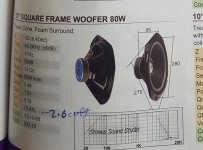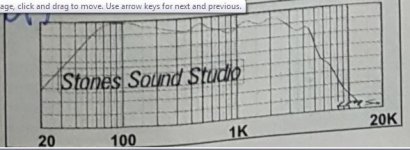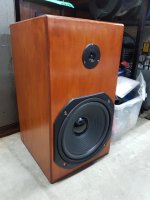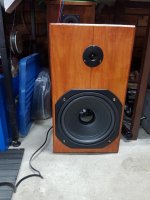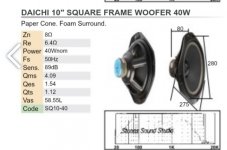Hi all. I have built a pair of 2 way sealed box speakers which comprise of a 10" woofer and a 1" dome tweeter. Xover is a linkwitz riley and xover point is at 4000Hz. The box is somewhat undersized and I have used some polyfill to improve
The woofer's performance. Qtc is at about 1.2. Despite the high Qtc the bass is not that boomy and works OK. Box resonance is about 71Hz and f3 is about 63Hz. When I turn up the volume the mids from the woofer tend to swamp out the bass.
My question is can I use some sort of equalization
To dip the mids to melow out the sound. I have read that a BSC may be used and if so can it be applied after the xover. Othereise please advise what else I can do to improve this scenario.
Kind regards
Billy D...
The woofer's performance. Qtc is at about 1.2. Despite the high Qtc the bass is not that boomy and works OK. Box resonance is about 71Hz and f3 is about 63Hz. When I turn up the volume the mids from the woofer tend to swamp out the bass.
My question is can I use some sort of equalization
To dip the mids to melow out the sound. I have read that a BSC may be used and if so can it be applied after the xover. Othereise please advise what else I can do to improve this scenario.
Kind regards
Billy D...
Your point about the mids swamping the bass, and your diagnosis about wanting to use some sort of equalisation, is what the Baffle step circuitry can achieve for you.
Did you design your crossover using measured data or use a calculator that takes resistance values to work out theoretical values? Calculators tend to not give good results, as once you put your bass unit in a small box with a small frontal area you will get several dbs of boost from low frequencies to past 1Khz depending on baffle dimensions.
Also the impedance at 4Khz for a 10" woofer is probably not 8 ohms or so at that frequency
With measurements you usually combine the baffles step circuitry as part of your crossover design to get a flattish response.
Details of your drivers, the cabinet front dimensions and crossover circuitry will help.
As you may not have boxes of different size inductors to hand, if you wanted to experiment you could take the bass inductor from the other speaker and wire it in series with the existing inductor and see if that gets you nearer to where you want to be sound wise.
Did you design your crossover using measured data or use a calculator that takes resistance values to work out theoretical values? Calculators tend to not give good results, as once you put your bass unit in a small box with a small frontal area you will get several dbs of boost from low frequencies to past 1Khz depending on baffle dimensions.
Also the impedance at 4Khz for a 10" woofer is probably not 8 ohms or so at that frequency
With measurements you usually combine the baffles step circuitry as part of your crossover design to get a flattish response.
Details of your drivers, the cabinet front dimensions and crossover circuitry will help.
As you may not have boxes of different size inductors to hand, if you wanted to experiment you could take the bass inductor from the other speaker and wire it in series with the existing inductor and see if that gets you nearer to where you want to be sound wise.
The speaker specs are as follows:
Fo = 47 Hz
Vas = 73.5L or 2.6cuft
Qts = 0.78
Re = 6.4 ohms
The baffle width is 12 inches.
The xovers were done from an online calcultor.
They are 0.64mH inductors with 2.5uf capacitors.
I did manage to apply a 1mH inductor in series with the bass inductor and it did lower the mids down and sounded nicer. Just wondering if this is o.k. to do.
Regards
Billy D...
Fo = 47 Hz
Vas = 73.5L or 2.6cuft
Qts = 0.78
Re = 6.4 ohms
The baffle width is 12 inches.
The xovers were done from an online calcultor.
They are 0.64mH inductors with 2.5uf capacitors.
I did manage to apply a 1mH inductor in series with the bass inductor and it did lower the mids down and sounded nicer. Just wondering if this is o.k. to do.
Regards
Billy D...
Attachments
Last edited:
Just my 3 cents worth...
Judging from the response graph in the thumbnail, I would likely have tried to cross that speaker over at about 2khz. If you notice it begins to roll off at about 2k then there's a bump in the response... that is likely to be cone breakup which isn't going to sound pretty, so you want to attenuate it as much as you can.
There are a few soft dome tweeters around that will cross that low. If you are worried about overstressing them you can either use 2 4 ohm in series or 2 16 ohm in parallel.
You may also want to consider a second or third order crossover while you're at it.
Judging from the response graph in the thumbnail, I would likely have tried to cross that speaker over at about 2khz. If you notice it begins to roll off at about 2k then there's a bump in the response... that is likely to be cone breakup which isn't going to sound pretty, so you want to attenuate it as much as you can.
There are a few soft dome tweeters around that will cross that low. If you are worried about overstressing them you can either use 2 4 ohm in series or 2 16 ohm in parallel.
You may also want to consider a second or third order crossover while you're at it.
Attachments
Playing with the inductor should not cause a problem if you have a stable amplifier.
As you say your new additional inductor which brings the total up to 1.6mH is working better for you.
Thanks for the data, I forgot to ask for impedance data. Do you have an impedance graph, and could you tell us the makerof the driverI failed to find a studio sound 10" square woofer. Once we have a maker people can look at the manufacturers webpage for frequency and impedance graphs.
Do you know about loudspeaker design tools Xsim or Virtuix? it might be worth searching them out and reading the introduction on how to use them. They are free downloads for non commercial users.
Using software will help you immensely to get a better design. Tuning by ear takes a lot of time, but can be done, look for the sticky post at the top of the multi way page.
As you say your new additional inductor which brings the total up to 1.6mH is working better for you.
Thanks for the data, I forgot to ask for impedance data. Do you have an impedance graph, and could you tell us the makerof the driverI failed to find a studio sound 10" square woofer. Once we have a maker people can look at the manufacturers webpage for frequency and impedance graphs.
Do you know about loudspeaker design tools Xsim or Virtuix? it might be worth searching them out and reading the introduction on how to use them. They are free downloads for non commercial users.
Using software will help you immensely to get a better design. Tuning by ear takes a lot of time, but can be done, look for the sticky post at the top of the multi way page.
Last edited:
Is it this one in the link.
SQ10-80 Daichi 10" Square Frame Woofer 80W | Wagner Online Electronic Stores
I still haven't found impedance graph yet?
SQ10-80 Daichi 10" Square Frame Woofer 80W | Wagner Online Electronic Stores
I still haven't found impedance graph yet?
The driver is a Daichi SQ10-80. I couldnt find anything on the net. They might be exclusively made for Wagner Electronics.
I am going to modify the xover and change the bass inductor to 2mH. This will give me an almost 6dB dip at about 2kHz. Ill see how that will sound.
Regards
Billy D...
I am going to modify the xover and change the bass inductor to 2mH. This will give me an almost 6dB dip at about 2kHz. Ill see how that will sound.
Regards
Billy D...
Last edited:
Yes, I imagine 2mH will help a bit more, you are going in the right direction. When you have too much it will be dull and lack excitement, maybe even muddy sounding, if the term muddy can be used to describe sound.
I think a Boxsim would be helpful in guessing a rough xo schematic and then adjust the tweeter padding by ear. A simple 1st order electrical on woofer and 2nd order electrical on tweeter should suffice. Software can simulate baffle/enclosure well which beats the online calculator by far.
I have done an offset xover where I used a 2mH low pass and a 0.64mH and 2.7uf high pass. This gave me a dip (theoretically) of about 5dB dip at the lowest point at about 2000Hz. This to me has made the speakers sound very pleasing as before they were "in your face" with midrange. Now you have more bass since I have desensitized the mids out of the woofer. Mind you the mids are still prominent at a pleasing level. Some efficiency has been lost but no issue. Just another question to you all. Does a baffle step affect all speakers? Or on certain drivers. I didn't realise that the baffle facia affects the woofer's response depending on its width and height. Have I understood this theory correct?
Regards
Billy D...
Regards
Billy D...
Last edited:
Yes, you need to do some reading in terms of baffle step or diffraction loss.
If you can measure with a mic and soundcard etc it's a lot easier to see what is happening.
If you can measure with a mic and soundcard etc it's a lot easier to see what is happening.
IdThanks for all your inputs. I have learned a new parameter about speaker design. I am satisfied with rhis sealed box setup. I might upgrade the tweeter but I shall see.
Attachments
Last edited:
I guess it is worth noting that you do not always need to apply the full theoretical correction. This depends on where they are in the room. In the middle of a room away from boundaries you may need the full amount, as you move to be closer the wall or a corner the bass will start to come up. This may mean only a reasonable amount of correction is needed for the best overall sound balance. If you haven't already done so look up room gain. Another parameter to help you.
Last edited:
Billbo,
You could try an 8.2 ohm wire wound resistor across the inductor and see if that improves the midrange, you could also experiment by increasing that value in increments of an ohm or two until you arrive at the most pleasing balance in sound. It's a form of equalization.
C.M
You could try an 8.2 ohm wire wound resistor across the inductor and see if that improves the midrange, you could also experiment by increasing that value in increments of an ohm or two until you arrive at the most pleasing balance in sound. It's a form of equalization.
C.M
This article by Rod Elliot I like to refer to Baffle Step Compensation I've always thought his line level correction circuit looks good, but I have not tried it.
Tony.
Tony.
I would like to ask a silly question.
Why on Earth such speakers with a high Qts are made. They are almost impractical to get them optimal in a reasonable size box. They need such a large box. I have another pair 10" woofers which have a Qts of 1.1! What can I do with these?
I can only think to cut a hole in my wardrobe and fit them in there. Otherwise they are virtually unusable. Can I put these high Q drivers into any use?
Regards
Billy D...
Why on Earth such speakers with a high Qts are made. They are almost impractical to get them optimal in a reasonable size box. They need such a large box. I have another pair 10" woofers which have a Qts of 1.1! What can I do with these?
I can only think to cut a hole in my wardrobe and fit them in there. Otherwise they are virtually unusable. Can I put these high Q drivers into any use?
Regards
Billy D...
Last edited:
Very high Qts drivers are frequently used on open baffles but usually they are 12" or 15".
10" drivers might be OK in a smaller room.
10" drivers might be OK in a smaller room.
I have another pair 10" woofers which have a Qts of 1.1! What can I do with these?
Billy D...
Slow down, you'll give yourself a coronary.

Where are the specs, is it a lower quality cheap replacement type of a driver, something like that Wagner brand or ?
- Home
- Loudspeakers
- Multi-Way
- DIY sealed box project
